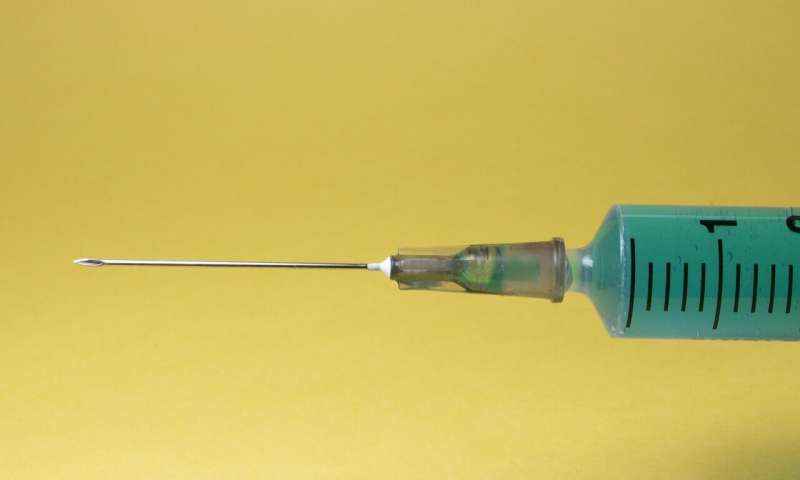
As the world waits for a COVID-19 vaccine, health officials worry that social media continues to be awash in misleading information about the virus and the safety of vaccines in general. A new study led by a Virginia Commonwealth University researcher may hold clues that could help public health officials in their efforts to combat false and potentially deadly information on social media.
The study, “(S)pin the Flu Vaccine: Recipes for Concern,” published in the journal Vaccine, is the first to analyze the content of Pinterest posts focused on the flu vaccine and was led by Jeanine Guidry, Ph.D., an assistant professor in the Richard T. Robertson School of Media and Culture in the College of Humanities and Sciences and director of the Media+Health Lab at VCU.
The World Health Organization estimates that influenza is connected to 290,000 to 650,000 deaths each year. Guidry and her collaborators decided to investigate how information about the virus is shared on Pinterest because of the platform’s primarily female user base and the central role women often play in their families’ health care decisions.
“Pinterest has a history of alarming proportions of vaccine misinformation, and this study actually showed that for flu vaccine focused posts, there was a somewhat more balanced presence—still a lot of misinformation and vaccine hesitancy posts, but more correct posts about this vaccine as well,” Guidry said. “That was an encouraging finding, although of course the presence of many vaccine hesitant posts is still an area of concern.”
The results may have been more mixed, Guidry said, because the flu vaccine is different than typical childhood vaccines, such as the measles, mumps, rubella vaccine or the HPV vaccine.
The study found that negative Pinterest posts about the flu vaccine—for example, discussing side effects, fear-provoking images, or self-efficacy to decline the vaccine—tended to produce higher engagement.
“[An] area of concern about these results is that pins associated with higher engagement appeared to be primarily associated with anti-vaccine variables and constructs: for example, pins that refer to perceived deadly consequences of the flu vaccine,” Guidry said.
And it found that posts with positive elements about the flu vaccine—such as health care professionals promoting the vaccine, the benefits of it, or cues to action to get the flu vaccine—tended to result in less engagement. Certain fear-provoking visuals (such as an image of a needle) also tended to increase engagement.
Meanwhile, perceived benefits of the flu vaccine and perceived barriers to it were found in roughly one-quarter of all vaccine related posts. And posts originating with Pinterest influencers—which may be more likely to be shared on the platform—were more likely to be pro-flu vaccine.
The study involved an analysis of 500 flu vaccine related Pinterest posts collected on Oct. 9, 2018. Since the sample was collected, Pinterest has taken action to reduce the amount of misinformation about vaccines, first by blocking searches for vaccine related pins in 2019 and later by announcing it would curate reliable posts about vaccines by organizations such as the WHO and the Centers for Disease Control and Prevention.
“Currently, we are studying Pinterest posts about a broad set of vaccine related search terms, to see what search results under the new Pinterest policies look like,” Guidry said.
The majority of the “pinners” in the sample were individuals, while only 5% of all posts were confirmed to either originate with official medical accounts (such as hospitals or health nonprofits) and government accounts such as the CDC. This was concerning, the researchers wrote, “since it appears to suggest that the public health voice—often likely to be one to provide trustworthy and reliable information—may be largely absent on this platform.”
The researchers applied a theory called the Health Belief Model to some of their analyses. The theory posits, in this case, a person’s belief in a personal threat of the flu together with a belief in the effectiveness of the vaccine will predict the likelihood the person will actually get the flu shot, Guidry said.
“A concern related to the study’s results is that the construct of perceived threat (how serious the flu is perceived to be, and how susceptible people think they themselves are) was barely present, meaning that even correct posts about the flu in this sample may not have made a Pinterest user more likely to decide to get the flu shot,” she said. “In addition, close to half of the visuals in this study included potentially fear-inducing components such as a huge needle or a visual of perceived horrific adverse effects of the flu vaccine.”
The study’s findings have implications for how information about COVID-19 and its potential vaccine in the future can be most effectively communicated.
“One of the things we are seeing on social media right now is a steady increase of anti-future COVID-19 vaccine posts,” Guidry said. “That is particularly concerning since the COVID-19 vaccine does not exist yet—although more than 150 versions are under development worldwide. One of my main concerns is that by the time that, hopefully, a safe and effective vaccine will be available, a certain percentage of people will not be willing to get the vaccine because they are convinced it is not safe.”
Although social media platforms are increasingly taking steps to correct or block false information and to promote reliable information, Guidry said these measures alone likely will not be enough.
Source: Read Full Article